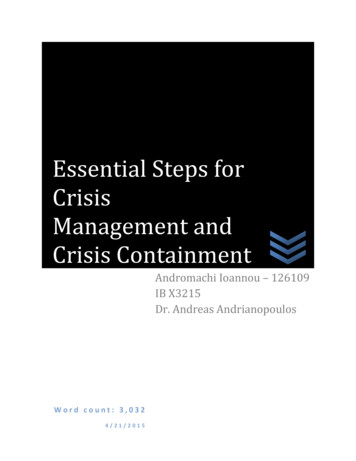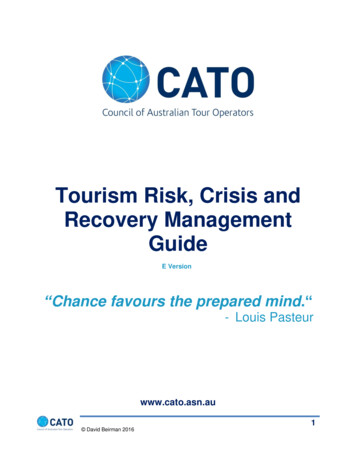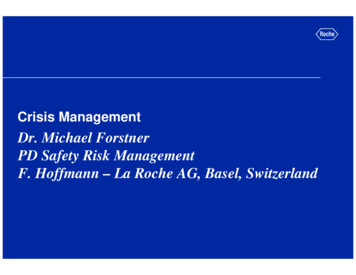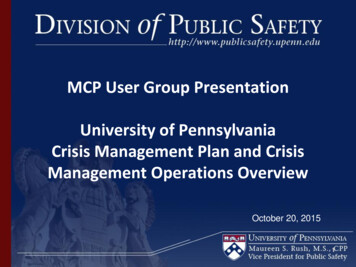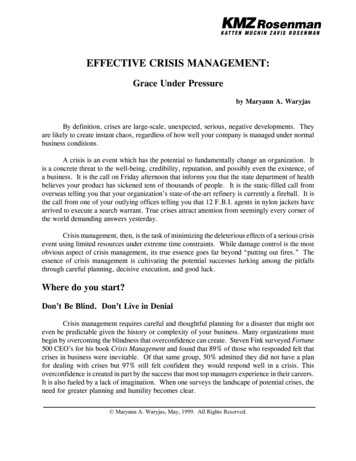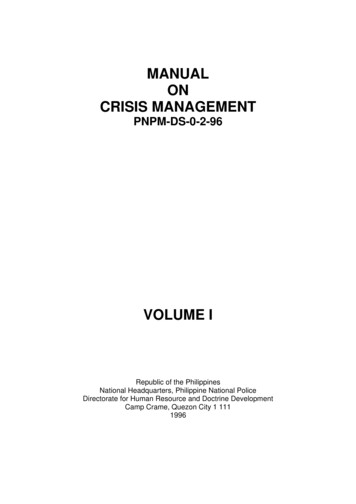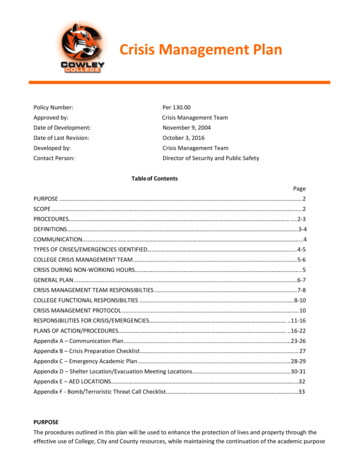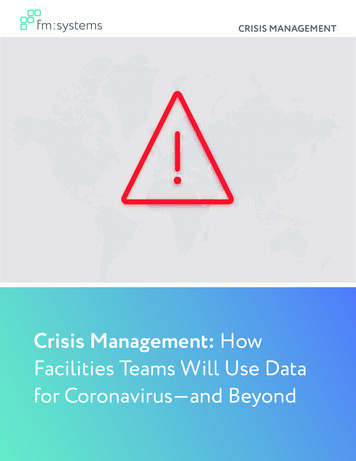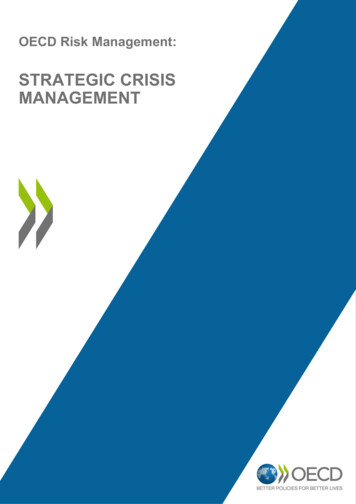
Transcription
OECD Risk Management:STRATEGIC CRISISMANAGEMENT
OECD Risk Management:Strategic Crisis ManagementCharles Baubion
3TABLE OF CONTENTSNote by the OECD Secretariat .41. Introduction .52. New forms of crises are calling for new and innovative crisis management responses .62.1 New nature of crisis.62.2 Increased vulnerabilities of modern societies.72.3 Changing roles of governments and increased demand from citizens and the media .72.4 A changing landscape for risk managers .83. Managing crises remains at the core of government’s roles in risk management .84. Crisis management: traditional approach vs. dealing with novelty .94.1 Crisis management frameworks and concepts .94.2 Crisis Preparedness: planning scenarios vs. preparing for the unknown .104.2.1 Risk assessment: sectoral analysis based on historical events vs. national risk assessment .104.2.2. Emergency planning: scenario-based vs. capability-based and network building .134.2.3. Training: testing plans and procedures vs. strategic exercises and networks building .154.2.4 Activation: Early Warning Systems triggering emergency plans vs. strategic foresight .164.3 Response: Command and Control vs. adaptative capacities .184.3.1 Operational picture: Crisis development monitoring vs. sense-making .184.3.2 Response: Standard Operating Procedures vs. managing large response network .194.3.3 Leadership: crisis communication vs. meaning-making .204.3.4 End of crisis: improving crisis response vs. rebuilding trust .215. Identifying key cross-cutting issues in inter-agency crisis management .22BIBLIOGRAPHY .25BoxesBox 1. The System for the Analysis and Visualisation of Risk Scenarios in Mexico .11Box 2. The Netherlands’ National Risk Assessment .12Box 3. Plan SISMO in Mexico, a good example of scenario-based emergency planning.13Box 4. Sharing common values all along a diversified response network.14Box 5. Strategic Crisis Management Exercises: examples from Germany and Switzerland .16Box 6. Integrated Early Warning System in Korea .16Box 7. Measuring geopolitical tensions based on market forces .17Box 8. United States Incident Command System .18Box 9. UK Science Advisory Group in Emergencies (SAGE) .19Box 10. Italy Civil Protection Operational Committee at national level with all stakeholders .20Box 11. International co-operation frameworks supporting crisis management .24STRATEGIC CRISIS MANAGEMENT OECD 2013
4Note by the OECD SecretariatThis work was conducted as part of the OECD High-Level Risk Forum, established in 2011 to offer avenue to achieve a shared and defined vision of integrated risk management, of which inter-agency crisismanagement is a core component. This report draws on the discussions held at the occasion of theworkshop on Inter-Agency Crisis Management organised jointly organised by the OECD and the SwissFederal Chancellery in Geneva, Switzerland on 28 June 2012. The workshop gathered 40 participants from12 OECD countries, academia, the private sector and international organisations to discuss the challengesthat they are confronted with in crises management. The agenda, summary and key presentations at theworkshop can be found oninter-agencycrisismanagement.htmThe goal of this report is to: highlight the changing landscape of crisis, discuss and assess practices of crisis management, contribute to identifying good practice.This report identifies five topics as key cross-cutting public governance issues that crisis managementpolicies and practices should pay attention to: an overall crisis governance framework, the role of scienceand expertise, leadership issues, the governance of networks, and international cooperation. Internationalexchange of experiences among governments and the development of common approaches is the aim ofthe High Level Risk Forum of the OECD. As developing principles on risk management is one of theForum’s objectives, these five areas could feed into the development of principles on crisis management.The establishment of a network of crisis managers under the auspices of the OECD High-Level RiskForum will further develop these exchanges of good practices. Developing a knowledge hub on crisismanagement and expanding its reflections to international co-operation to support crisis management areoptions for further work of this network.This report, written by Charles Baubion, benefited from comments and feedback from Jack Radischand was prepared under the supervision of Stéphane Jacobzone from the Public Governance and TerritorialDevelopment Directorate of the OECD. Production assistance was provided by Lia Beyeler.11The OECD Secretariat is grateful for the support received from the Swiss Federal Chancellery to hold a jointworkshop with OECD on interagency crisis management, and wishes to thank Dr. Nicolas Mueller and Dr. ChristophDoktor from its Federal Crisis Management & Strategic Leadership Training Center. This research was also madepossible thanks to the financial support of the governments of France, Korea, Norway, Sweden and the United States,as well as AXA, EADS, Oliver Wyman and Swiss Re to the OECD High Level Risk Forum(www.oecd.org/gov/risk).STRATEGIC CRISIS MANAGEMENT OECD 2013
51. IntroductionGovernments are confronted with an increasing number of crises, often consisting of new threats.They may spread beyond national borders and may create significant economic knock-on effects. TheOECD report on Future Global Shocks (OECD, 2011) highlights the vulnerabilities of our interconnected,global economy. In the wake of the financial and fiscal crises, global leaders are acutely aware that furthersystemic shocks could severely challenge economic recovery, social cohesion and even political stability.Governments are always at the forefront of efforts to manage these disruptive events, and citizens' trust ingovernment is directly affected by how swiftly and efficiently governments react in crisis situation.The complexities of modern crises often require the involvement of many actors, above and beyondemergency services, and this demands effective co-ordination for a successful outcome. The need for coordination also raises significant public governance challenges, as crisis management functions are oftenexercised at sub-national levels, but co-ordinated at the centres of governments. The capacity to coordinate crisis management is a fundamental element of good governance, as it tests governments' capacityto provide the appropriate responses at the right time, in order to protect their citizens and businesses andmitigate the impact of disasters. Ensuring that national authorities have the right tools and institutionalframework for co-ordinated action is critical.Most OECD governments have taken these evolutions of the risk and crisis landscape intoconsideration, and crisis management systems have been reformed over the last decade, in order to adapt tothis new context. However, crises continue to evolve, challenging even the most recent and robust systems.This report highlights the changing landscape of crises with which governments are confronted today.How does this require governments to adapt their approaches, capacities and tools in various areas of crisismanagement towards more flexibility? The report discusses different approaches and practices in dealingwith both traditional and novel crises, asking how best governments can adapt to change while stillmaintaining capabilities to deal with more classic crises.STRATEGIC CRISIS MANAGEMENT OECD 2013
62. New forms of crises are calling for new and innovative crisis managementresponses2.1 New nature of crisisRecent crises have challenged political leadership and risk managers in many countries, often due tounexpected or unforeseen circumstances, but also due to weak links and breakdowns in information flow.Examples include the events of 11 September 2001, the SARS and H1N1 pandemic outbreaks in 2003 and2009, the 2004 Indian Ocean tsunami, Hurricane Katrina in 2005, the 2010 Iceland volcanic eruption andits ash cloud over Europe or the 2011 Tohoku earthquake in eastern Japan, in which the tsunami and theFukushima Daiichi nuclear accident resulted in cascade effects (Figure 1). In these cases, risk managers,processes and structures were unprepared to deal withThese new crises differ significantly from the past in several respects: their unexpectedly large scale, the fact that they are new or unprecedented – at least in human or crisis managers’ memories – ortheir unusual combination (D. Leonard, 2012), their trans-boundary nature (Ansell, Boin, Keller, 2010). A trans-boundary crisis spreads acrossgeographic borders (between nations, States or other local authorities) and/or policy boundaries(between administrations, sectors, public-private etc). These crises bring deep uncertainties andchallenge government structures, playing up tensions between many stakeholders in the publicand private sectors.Figure 1. Cascading effects of the Great East Japan EarthquakeSource: Government of JapanSTRATEGIC CRISIS MANAGEMENT OECD 2013
7These trans-boundary effects can expand to become what OECD has characterised as a “globalshock”, that is, a “rapid onset event with severely disruptive consequences covering at least twocontinents” (OECD, 2011). This concept also takes into account another pattern of novel crisis: cascadingrisks that become active threats as they spread across global systems, whether these arise in health, climate,social or financial systems. A traditional crisis can become trans-boundary and even develop into a globalshock at a later stage, through non-linear processes.2.2 Increased vulnerabilities of modern societiesThese various characterisations of a new crisis landscape reflect the idea that the 21st century is likelyto witness increasingly damaging and costly shocks. Our societies are becoming not only more complexand interconnected, but also increasingly vulnerable and exposed, as new or different threats may emergeand spread more quickly through spill-over or amplifier effects.Future Global Shocks (OECD, 2011) identified key macro drivers that augment vulnerability andamplify consequences of more classic crises. The heightened mobility within our global world facilitatesthe spread of risk carriers or vectors, such as viruses or terrorists. Globalisation has also led to an increasedinterdependence of production and delivery systems and their infrastructure as well as to the centralisationand concentration of critical systems. Supply chains and networks of vital services are more and moreglobal and thus exposed to many hazards and threats. They are also vulnerable, interdependent and oursocieties and economies are increasingly relying on them for their daily functioning and operations. Acrisis affecting one node of such a system might affect the whole, with large-scale cascading impacts.Urbanisation and the concentration of populations and assets further exacerbate societies’ vulnerabilitiesby creating hot-spots for catastrophic events with a huge potential for direct losses, as well as by beingattractive targets for terrorist attacks.The characteristics of hazards and threats are changing as well. An increase in the frequency andseverity of extreme weather events may accompany climate change, and rising sea-levels will endangercoastlines where most megacities are developing. New infectious diseases are appearing regularly andspreading more quickly with increased mobility of economic activities. Terrorism and other intentionalacts are taking new forms as their agents are adapting their ways of operating within this new landscape.2.3 Changing roles of governments and increased demand from citizens and the mediaIn addition to the emergence of new threats and vulnerabilities, elements to consider in the changingparadigm for crisis managers relate to the evolution of governments. While crisis management will alwaysremain one of their fundamental roles, the wave of privatisation and decentralisation has reduced overallcapacities in many governments to take direct actions to prevent or mitigate risks in s
ordinate crisis management is a fundamental element of good governance, as it tests governments' capacity to provide the appropriate responses at the right time, in order to protect their citizens and businesses and mitigate the impact of disasters. Ensuring that national authorities have the right tools and institutional framework for co-ordinated action is critical. Most OECD governments .
